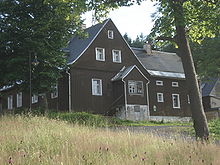Dish houses
|
Dish houses
Municipality of Breitenbrunn / Erzgeb.
Coordinates: 50 ° 26 ′ 7 ″ N , 12 ° 53 ′ 35 ″ E
|
||
|---|---|---|
| Height : | 919 m above sea level NN | |
| Residents : | 125 (May 9, 2011) | |
| Incorporation : | March 1, 1994 | |
| Incorporated into: | Knight green | |
| Postal code : | 08359 | |
| Area code : | 037348 | |
|
Location of Tellerhäuser in Saxony |
||
Tellerhäuser is part of the municipality of Breitenbrunn / Erzgeb. in the Erzgebirgskreis in Saxony , Germany .
Geographical location
The district is located in one of the largest contiguous forest areas in Saxony directly on the border with the Czech Republic in the valley of the Klingerbach, which is called Pöhlwasser after its confluence with the Höllbach near Zweibach . In the north, the Einsberg ridge stretches along Klöppelstrasse . The state road from Raschau to Oberwiesenthal runs through the village .
history
A miner named Andreas Teller laid the foundation stone for the small settlement. The out Gottesgab originating plate turned in 1650, when the Kingdom of Bohemia , the Counter-Reformation was exacerbated when Exulant in the territory of the Electorate of Saxony . His request to be allowed to build a house on Kaffenberg was approved by Elector Johann Georg I in 1652 , which can be seen as the time of the founding of Tellerhäuser. In Christian Lehmann's historical arena, there is an indication of the direction "to Teller's new house" in 1699 . A second house had been added a short time before. In 1791 there is still talk of an upper and a lower plate house, which, according to the historical directory of Blaschke, already formed an official village. The Saxon church gallery calls around 1840 "the 3 plate houses on the back" .
In 1824 August Schumann counted the three small estates in Tellerhäuser, among which was a forester's house, among the most populous in Saxony in his lexicon. A school teacher was employed for the 37 children at the time, as the way to school in one of the neighboring towns would not have been reasonable. In contrast, Tellerhäuser has always been a parish of Oberwiesenthal. A two and a half hour walk was necessary to go to church, which in winter was often very difficult or impossible.
In 1801 Tellerhäuser had 31 residents. Between 1834 and 1890, the population tripled from 41 to 119. The population growth was followed by an increase in the number of visitors at the turn of the century, as plate houses established themselves as a destination for summer and, above all, winter visitors . In addition to the popular Gasthaus Schneider, several guest houses provided accommodation for the guests . In the years that followed, Tellerhäuser remained a popular holiday destination, mainly because of its guaranteed snow. The population did not increase significantly in the following hundred years compared to 1890 (1990: 148 inhabitants). The political community of Tellerhäuser was founded in the forester's house after the introduction of the Saxon rural community code of 1838 . In 1994 Tellerhäuser, which until then was known as the highest village in Saxony, lost its independence and became part of the Rittersgrün community together with the Zweibach group of houses . In the course of the incorporation of Rittersgrün, the place became a district of Breitenbrunn on January 1, 2007.
From Tellerhäuser the German-Czech border runs in a north-westerly direction over the Kaffenberg to Ehrenzipfel and on to Johanngeorgenstadt or in a south-easterly direction to Oberwiesenthal. The extensive forest area around the village can be used for hiking and ski tours (cross-border trails) in summer and winter.
Development of the population
|
|
|
Culture and sights
- Cross-border Anton-Günther-Weg
People connected to the place
- Alwin Teumer (1828–1890), forester in Tellerhäuser and an original in the western Ore Mountains.
- Hans Siegert (1868–1941), Ore Mountains native poet, grew up with his grandparents in Tellerhäuser.
- Martin Mutschmann (1879–1947), Saxon Reich Governor and Prime Minister, was arrested on May 16, 1945 while on the run in the merchant's house in Tellerhäuser.
Others
The novel Zwei Ways by Hans Siegert, published in 1922, is about Tellerhäuser, which is called Wildhäuser there .
literature
- Eduin Bauer : The plate houses at the Fichtelberge , Stuttgart 1891.
- Dish houses. In: From Annaberg to Oberwiesenthal (= values of the German homeland . Volume 13). 1st edition. Akademie Verlag, Berlin 1968, pp. 165f.
- Jonny Hielscher: The founding document for Tellerhäuser , in: Erzgebirgische Heimatblätter 37 (2015), Issue 3, pp. 2-4. ISSN 0232-6078
Web links
- Tellerhäuser in the Digital Historical Directory of Saxony
Individual evidence
- ↑ Small-scale municipality sheet for Breitenbrunn / Erzgeb. (PDF; 0.23 MB) State Statistical Office of the Free State of Saxony , September 2014, accessed on January 27, 2015 .
- ↑ Jonny Hielscher: The founding document for Tellerhäuser , in: Erzgebirgische Heimatblätter 37 (2015), Heft 3, pp. 2-4.
- ↑ Christian Lehmann: Historical scene… . 1699, p. 129. ( digitized version )
- ↑ Cf. Tellerhäuser in the Digital Historical Directory of Saxony




